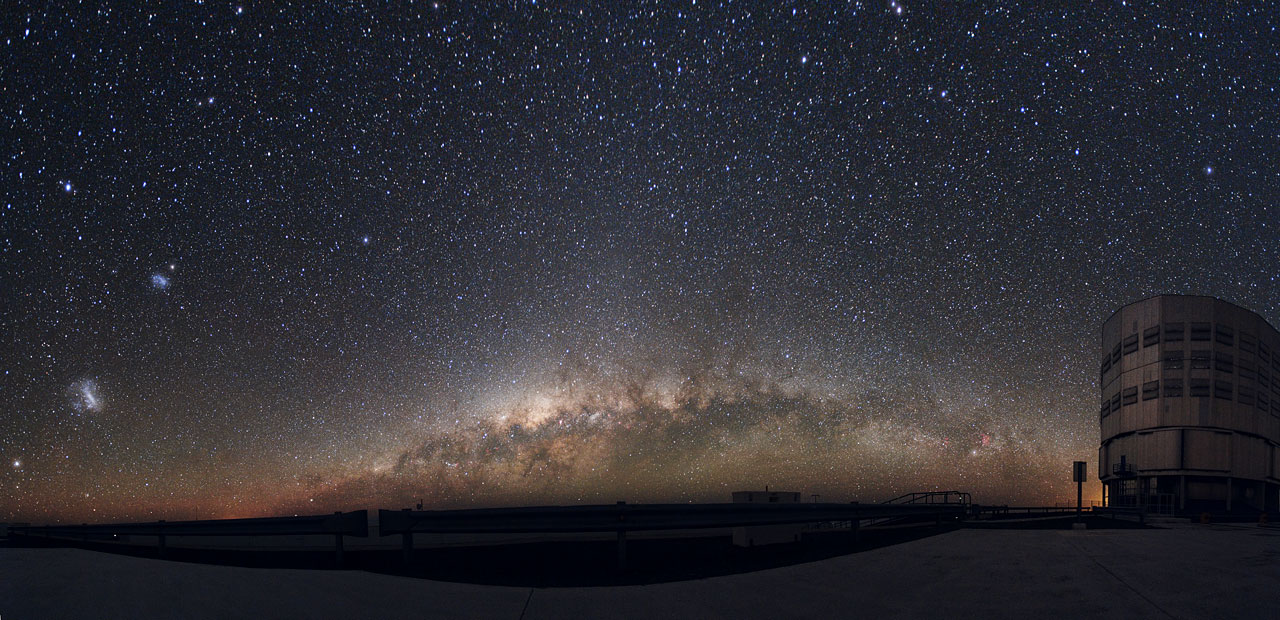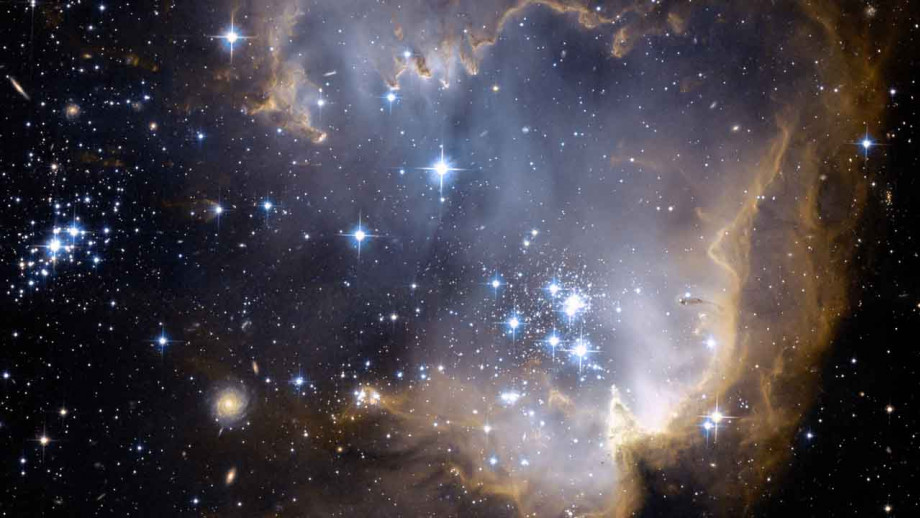Small Magellanic Cloud: A Satellite Dwarf Galaxy Neighbor
A diffuse fog in the southern sky, the Small Magellanic Cloud (SMC) is one of our Milky Way galaxy's closest neighbors. Because it cannot be seen from most of North America, northern Africa, Europe or Asia, the SMC remained hidden from the cultures that dominated these continents. But in the Southern Hemisphere, the SMC was more prominent; a regular presence in Australian aboriginal stories, it helped early Polynesian cultures navigate the seas.
Portuguese explorer Ferdinand Magellan was the first to document the SMC and its companion galaxy, the Large Magellanic Cloud (LMC), doing so between the years 1519 and 1522. The galaxy pair was later named for the famous world traveler, who identified them while on his final journey to discover a western route to Indonesia.
A new look at old galaxies
The SMC lies approximately 200,000 light-years from the Milky Way, making it the fourth-closest neighbor to our galaxy, according to NASA’s Imagine the Universe. Along with the Milky Way and the LMC, the SMC makes up the Local Group, a collection of about 30 galaxies located in the same neighborhood.
The SMC stretches across the sky, reaching about 7,000 light-years across, according to the Herschel Space Observatory. Viewers on Earth will see the SMC takes up as much room in the sky as nine or 10 full moons. Relatively small for a galaxy, it may still contain as many as a few hundred million stars, according to EarthSky.org.

The LMC and the SMC share an unusual shape that probably comes from their interaction with one another and with the Milky Way. The pair orbit one another about every 900 million years and circle the Milky Way about once every 1.5 billion years, according to the Swinburne Astronomy Online Encyclopedia of Astronomy.
For years, most astronomers assumed that the LMC and SMC had circled our galaxy multiple times. However, in 2007, research suggested that the two galaxies were making their first trip around the Milky Way. By using the Hubble Space Telescope to measure the speed of the galaxies relative to one another, University of Virginia astronomer Nitya Kallivayalil and her colleagues calculated the accurate 3D velocities of the LMC and SMC.
"We found that the velocities of the LMC and SMC are unexpectedly large — almost twice those previously thought," Kallivayalil, then a researcher at the Harvard-Smithsonian Center for Astrophysics, said in a statement.
There are two possible explanations for these high-speed galaxies: Either the Milky Way is larger than expected, or the Magellanic clouds are not gravitationally connected to our galaxy but are just passing by.
Additional research from Gurtina Besla, an astronomer at the University of Arizona, revealed that the galaxy pair is indeed bound to the Milky Way, which is more massive than originally thought. At the same time, Besla said that understanding the mass of the Milky Way "completely changes" our picture of the history of the Magellanic clouds.

A window to the universe
The close proximity of the SMC to the Milky Way helps astronomers to study what's going on outside of our galaxy. One of the biggest obstacles in studying how stars form and evolve is interstellar dust, the gas and debris that lie between the stars. Clouds of tiny grains can scatter and absorb light emitted from the stars, distorting our view of those objects.
At the start of the 20th century, Harvard College Observatory astronomer Henrietta Leavitt used a class of changing stars known as Cepheid variables within the SMC to discover a relationship between the brightness of Cepheids and how long they flared. The measure of this relationship has played a key role in determining distances to objects in the universe.
Astronomers have also used the European Southern Observatory (ESO) Very Large Telescope (VLT) in Chile, along with other instruments, to identify, for the first time, an isolated neutron star with low-energy magnetic field located outside the Milky Way. Researchers discovered the star at the center of a ring of gas expanding slowly amid other rings of gas and dust that were left behind after a supernova in the SMC.
"If you look for a point source, it doesn't get much better than when the universe quite literally draws a circle around it to show you where to look," lead author Frédéric Vogt, an ESO fellow in Chile, said in a statement.
Astronomers have also mapped cosmic rays from the SMC and its neighboring LMC in unprecedented detail, thanks to data from the Murchison Widefield Array radio telescope in Australia. Cosmic rays are charged particles emitted from supernova explosions that interact with magnetic fields, creating radiation visible to radio telescopes. Identifying the rays allows scientists to estimate the number of new stars being formed. Researchers estimated that the rate of star formation in the SMC is roughly equivalent to one new star with the mass of our sun every 40 years, according to a statement from the International Centre for Radio Astronomy Research.

In addition to producing insights about star formation, astronomers have learned that the SMC is slowly splitting apart. University of Michigan astronomer and lead author Sally Oey and her colleagues used data from the European Space Agency's Gaia space telescope to track massive, hot young stars in SMC. In the process, the researchers found that all the stars within the southeastern region of the SMC are moving in a similar direction and speed, away from the rest of the galaxy and toward the LMC. This suggests that the LMC and SMC likely collided a few hundred million years ago, causing those stars to be pulled away. The results were published in 2018 in The Astrophysical Journal Letters.
Astronomers have also zeroed in on the coming demise of the SMC. By studying the cloud using the Australian SKA Pathfinder (ASKAP) radio telescope array, astronomers have been able to track the slow death of the cloud.
"We were able to observe a powerful outflow of hydrogen gas from the Small Magellanic Cloud," lead researcher Naomi McClure-Griffiths, of the Australian National University, said in a statement. Gas flowing out of the galaxy is lost to the star-formation process; once all of the gas is gone, no new stars can form. Galaxies that no longer form stars "gradually fade away into oblivion," she said.
As the SMC loses gas and slows in its star formation, it will eventually fall into more-massive objects, such as our own galaxy.
"Ultimately, the Small Magellanic Cloud is likely to eventually be gobbled up by our own Milky Way," McClure-Griffiths said.
Additional resources:
- Take a video tour of the Large and Small Magellanic Clouds, courtesy of NASA.
- Check out some impressive images of the SMC from CalTech’s Infrared Processing & Analysis Center.
- Learn more about satellite galaxies from NASA’s Space Place.
Join our Space Forums to keep talking space on the latest missions, night sky and more! And if you have a news tip, correction or comment, let us know at: community@space.com.
Get the Space.com Newsletter
Breaking space news, the latest updates on rocket launches, skywatching events and more!

Nola Taylor Tillman is a contributing writer for Space.com. She loves all things space and astronomy-related, and enjoys the opportunity to learn more. She has a Bachelor’s degree in English and Astrophysics from Agnes Scott college and served as an intern at Sky & Telescope magazine. In her free time, she homeschools her four children. Follow her on Twitter at @NolaTRedd










